Vill du ha en säker plats där du kan experimentera med din WordPress-webbplats utan att vara rädd för att förstöra något på din live-webbplats?
Att flytta din WordPress-webbplats till en lokal server på din dator är enligt vår mening den perfekta lösningen, särskilt för utvecklare, designers eller WordPress-nybörjare.
Genom att installera WordPress på din dator (lokal server) kan du enkelt lära dig WordPress och testa saker. När du flyttar en live WordPress-webbplats till en lokal server kan du experimentera med samma data som din live-webbplats.
I den här artikeln visar vi dig hur du enkelt flyttar en live WordPress-webbplats till en lokal server.
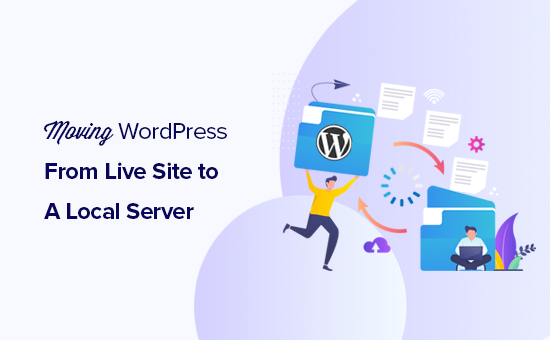
Varför och vem skulle vilja flytta en live WordPress webbplats till en lokal server?
Om du har drivit en WordPress-webbplats under en tid kanske du vill testa nya teman eller ett plugin. Om du gör detta på en live-webbplats kan det dock leda till en dålig användarupplevelse för dina användare.
För att undvika detta skapar många användare en kopia av sin WordPress-webbplats på en lokal server för att testa nya teman, plugins eller göra utvecklingstester.
På så sätt kan du skapa ditt tema med allt ditt innehåll och testa alla funktioner utan att behöva oroa dig för att din webbplats ska gå sönder. Många användare kopierar sin webbplats till en lokal server för att öva sina WordPress- och kodningskunskaper med faktiska webbplatsdata.
Även om du kan göra alla tester med dummy-innehåll i WordPress, ger verkliga webbplatsdata dig en bättre visuell representation av hur dessa ändringar kommer att se ut på din live-webbplats.
Förberedelser för att flytta en lokal webbplats till en lokal server
Först måste du se till att du alltid säkerhetskopierar din WordPress-webbplats. Det finns flera bra plugins för säkerhetskopiering av WordPress som du kan använda.
För det andra måste du installera en lokal servermiljö på din dator. Du kan använda WAMP för Windows och MAMP för Mac. När du har ställt in miljön måste du skapa en ny databas med phpMyAdmin.
Besök bara följande URL i din webbläsare för att starta phpMyAdmin.
http://localhost/phpmyadmin/
http://localhost:8080/phpmyadmin/
Härifrån klickar du på fliken “Databaser” och skapar en ny databas. Du behöver den här databasen för att senare kunna packa upp data från din live-webbplats.

Du är nu redo att flytta din live WordPress-webbplats till en lokal server.
Metod 1. Flytta live WordPress-webbplats till lokal server med hjälp av plugin
Den här metoden är enklare och rekommenderas för alla användare.
Det första du behöver göra är att installera och aktivera pluginet Duplicator. För mer information, se vår steg för steg-guide om hur du installerar ett WordPress-plugin.
Med Duplicator kan du enkelt skapa ett duplicerat paket av hela din webbplats. Det kan användas för att flytta din WordPress-webbplats till en ny plats och kan också användas som ett backup-plugin.
Obs: Det finns en gratis version av Duplicator som du kan komma igång med. Duplicator Pro kommer dock med obegränsade säkerhetskopior och mer avancerade funktioner.
Efter aktivering, gå till Duplicator Pro ” Säkerhetskopior från din WordPress admin sidofält. För att skapa ett nytt paket måste du klicka på knappen “Lägg till nytt”.
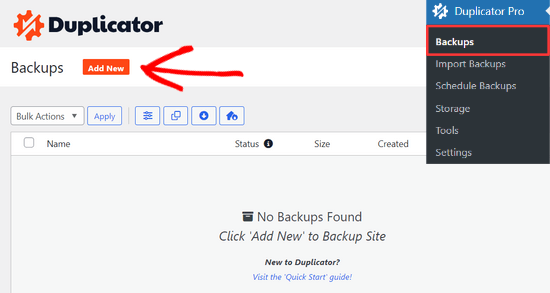
Duplicator startar sedan guiden för säkerhetskopiering.
Först måste du ange ett namn för ditt backup-paket. Du kan också använda de dynamiska taggarna för att automatiskt skapa ett namnformat som datum och webbplatsens titel.

Expandera sedan avsnittet “Storage” och välj en lagringsplats.
I den här handledningen använder vi standardplatsen. Du kan klicka på länken “Lägg till lagring” för att lägga till en ny plats, som Dropbox eller Google Drive, om du vill.
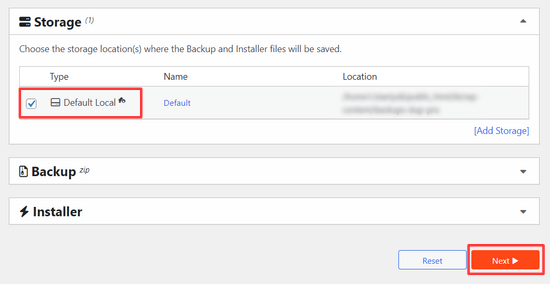
Klicka på knappen “Nästa” för att fortsätta.
Pluginet kommer sedan att skanna din webbplats och köra några bakgrundskontroller. Det kommer sedan att visa dig en sammanfattning av dessa kontroller.
Om allt ser bra ut klickar du på knappen“Skapa säkerhetskopia” för att fortsätta.
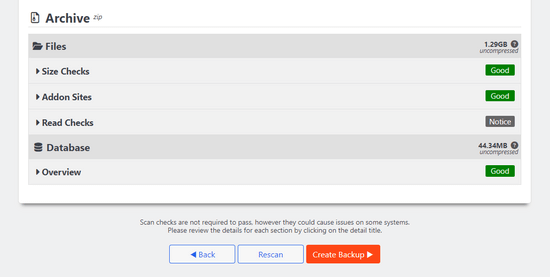
Duplicator kommer nu att skapa ditt webbplatspaket.
När du är klar ser du en zip-fil med arkiv som innehåller alla dina webbplatsdata och en installationsfil. Du måste ladda ner båda filerna till din dator.
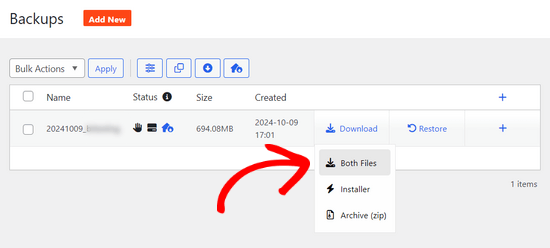
Du är nu redo att packa upp och installera dessa filer på din lokala server.
Först måste du skapa en ny mapp i den lokala serverns rotmapp. Det är den mapp där den lokala servern lagrar alla webbplatser.
Om du till exempel använder MAMP kommer det att vara /Applications/MAMP/htdocs/mappen. Alternativt om du använder WAMP, då skulle det vara C:\wamp\www\ mapp.
I den här mappen kan du skapa nya mappar för varje ny webbplats som du vill importera eller skapa på din lokala server.
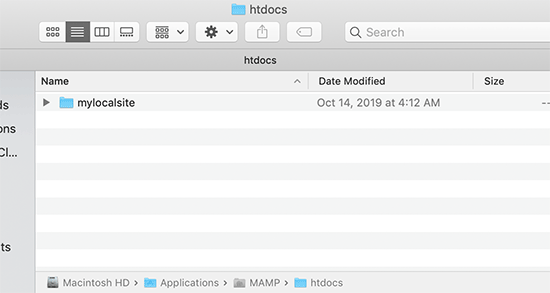
Därefter måste du öppna mappen som du skapade för din lokala webbplats och sedan kopiera och klistra in både arkivets zip-fil och installationsskriptet som du hämtade tidigare.
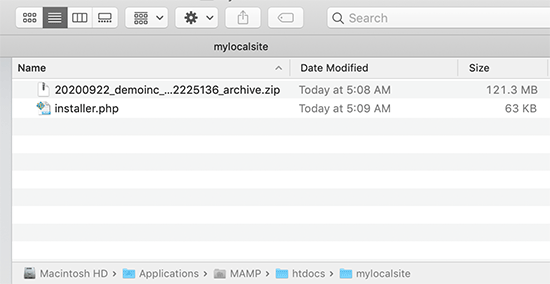
För att köra installationen måste du öppna skriptet installer.php i din webbläsare.
Om du t.ex. klistrade in båda filerna i mappen /mylocalsite/ kommer du åt dem i din webbläsare genom att besöka http://localhost/mylocalsite/installer.php.
Du kommer nu att se installationsskriptet för Duplicator så här:
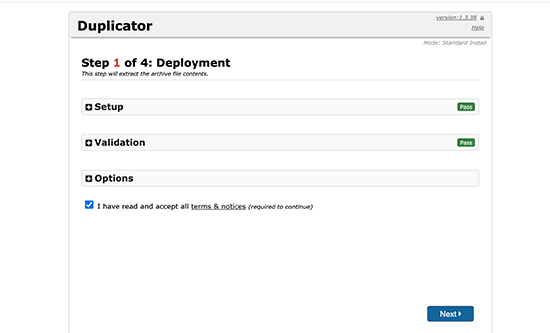
Klicka på knappen “Nästa” för att fortsätta.
Duplicator packar nu upp arkivets zip-fil och ber dig ange databasinformationen för din lokala webbplats. Detta är den databas som du skapade tidigare.
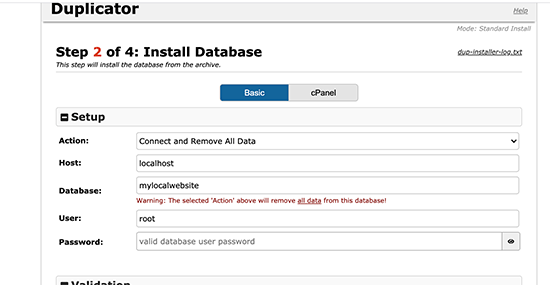
Servernamnet är nästan alltid localhost och användarnamnet är root. I de flesta fall har din lokala serverinstallation inget lösenord för root, så du kan lämna den tom.
Längst ner på sidan finns en “Test Database”-knapp som du kan använda för att kontrollera att databasinformationen är korrekt.
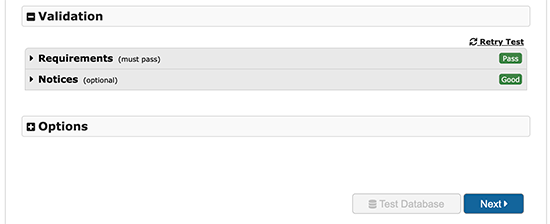
Om allt ser bra ut klickar du på knappen “Nästa” för att fortsätta.
Duplicator kommer nu att importera din WordPress-databas. Därefter ber den dig att dubbelkontrollera den nya webbplatsinformationen som den automatiskt har upptäckt.
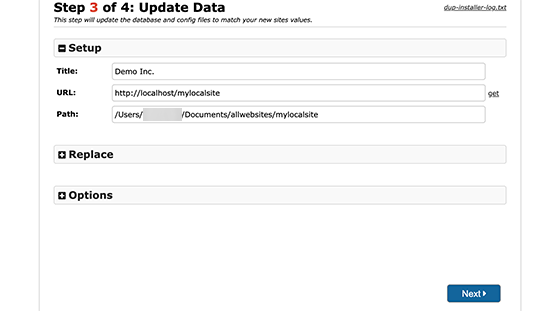
Klicka på knappen “Nästa” för att fortsätta.
Duplicator kommer nu att avsluta installationen och visa dig en knapp för att logga in på din lokala webbplats. Du använder samma WordPress-användarnamn och lösenord som du använder på din live-webbplats.
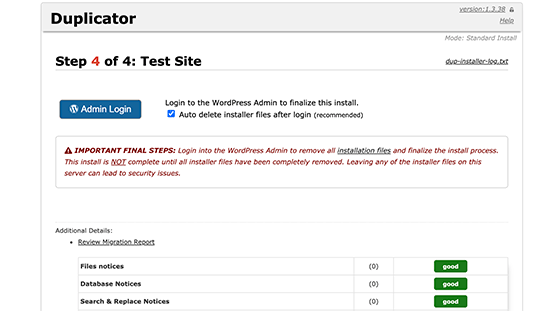
Det var allt, du har lyckats flytta din live-webbplats till den lokala servern.
Metod 2. Flytta en live WordPress-webbplats manuellt till en lokal server
Om insticksprogrammet inte fungerar för dig kan du alltid flytta din live-webbplats manuellt till en lokal server. Det första du behöver göra är att säkerhetskopiera din webbplats manuellt från ditt WordPress-värdkonto.
Steg 1. Exportera WordPress-databasen för din live-webbplats
För att exportera WordPress-databasen för din live-webbplats måste du logga in på din cPanel-instrumentpanel och klicka på phpMyAdmin.
Obs: Vi visar skärmdumpar från Bluehost-instrumentpanelen.
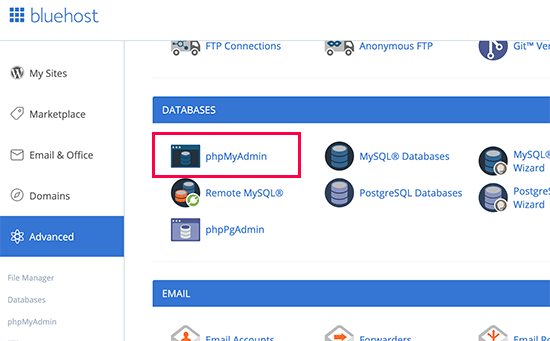
Inuti phpMyAdmin måste du välja den databas du vill exportera och sedan klicka på exportfliken längst upp.
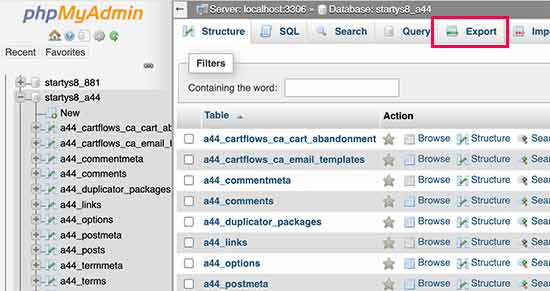
phpMyAdmin kommer nu att be dig att välja antingen snabb eller anpassad exportmetod. Vi rekommenderar att du använder anpassad metod och väljer zip som komprimeringsmetod.
Ibland kan WordPress-plugins skapa egna tabeller i din WordPress-databas. Om du inte längre använder det insticksprogrammet kan du utesluta dessa tabeller med den anpassade metoden.
Lämna resten av alternativen som de är och klicka på “Go” -knappen för att ladda ner din databasbackup i zip-format.
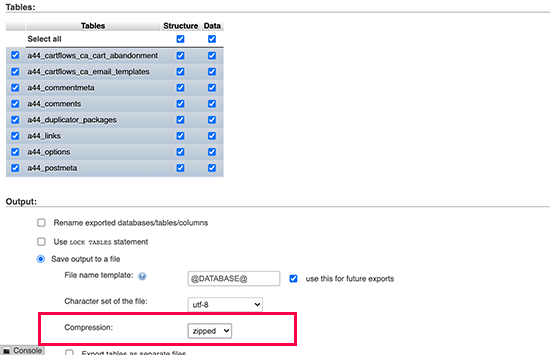
phpMyAdmin kommer nu att ladda ner din databasfil. För mer information, se vår handledning om hur du säkerhetskopierar din WordPress-databas manuellt.
Steg 2. Ladda ner alla dina WordPress-filer
Nästa steg är att ladda ner dina WordPress-filer. För att göra det måste du ansluta till din WordPress-webbplats med hjälp av en FTP-klient.
När du är ansluten väljer du alla dina WordPress-filer och laddar ner dem till din dator.
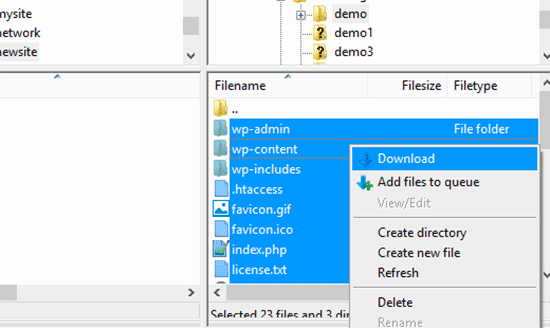
Steg 3. Importera dina WordPress-filer och din databas till den lokala servern
När du har laddat ner dina WordPress-filer måste du skapa en mapp på din lokala server där du vill importera den lokala webbplatsen.
Om du använder WAMP vill du skapa en mapp i mappen C:\wamp\www\ för din lokala webbplats. MAMP-användare måste skapa en mapp i mappen /Applications/MAMP/htdocs/.
Därefter är det bara att kopiera och klistra in dina WordPress-filer i den nya mappen.
Därefter måste du importera din WordPress-databas. Öppna helt enkelt phpMyAdmin på din lokala server genom att besöka följande URL:
http://localhost/phpmyadmin/
Eftersom du redan har skapat databasen tidigare måste du nu markera den och sedan klicka på fliken “Import” högst upp.
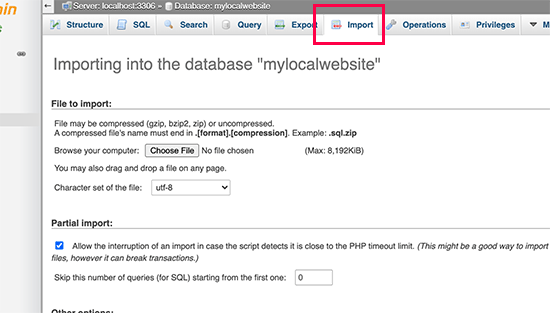
Klicka på knappen “Choose File” för att välja och ladda upp den databasexportfil som du laddade ner i det första steget. Därefter klickar du på knappen “Go” längst ner på sidan.
phpMyAdmin kommer nu att packa upp och importera din WordPress-databas.
Nu när din databas är klar måste du uppdatera webbadresserna i din WordPress-databas som hänvisar till din live-webbplats.
Du kan göra detta genom att köra en SQL-fråga i phpMyAdmin. Se till att du har valt din lokala webbplats databas och klicka sedan på SQL.
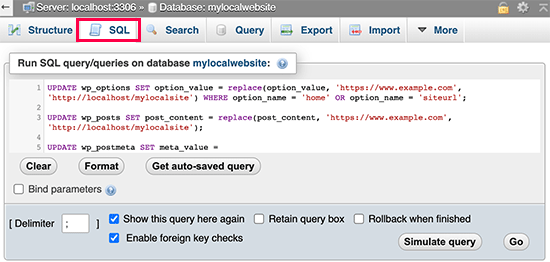
I phpMyAdmins SQL-skärm kopierar och klistrar du in den här koden, se till att du ersätter example.com med din live-webbplats URL och http://localhost/mylocalsite med den lokala serverns URL för din webbplats.
UPDATE wp_options SET option_value = replace(option_value,'https://www.example.com','http://localhost/mylocalsite') WHERE option_name ='home'OR option_name ='siteurl';UPDATE wp_posts SET post_content = replace(post_content,'https://www.example.com','http://localhost/mylocalsite');UPDATE wp_postmeta SET meta_value = replace(meta_value,'https://www.example.com','http://localhost/mylocalsite');
Den här frågan ersätter referenser till webbadressen till din live-webbplats från databasen och ersätter den med webbadressen till det lokala webbhotellet.
Steg 4. Uppdatera filen wp-config.php
Det sista steget är att uppdatera filen wp-config.php på din lokala webbplats. Den här filen innehåller WordPress-inställningar, bland annat hur du ansluter till din WordPress-databas.
Gå bara till mappen där du installerade WordPress på din lokala server och öppna sedan wp-config.php-filen i en textredigerare som Notepad.
Ersätt databasnamnet med det som du skapade i phpMyAdmin på ditt lokala webbhotell.
Därefter ersätter du databasens användarnamn med ditt lokala MySQL-användarnamn, vanligtvis är det root. Om du har angett ett lösenord för MySQL-användaren root på ditt lokala webbhotell anger du det lösenordet. Annars lämnar du den tom och sparar dina ändringar.
/** The name of the database for WordPress */define('DB_NAME','database_name_here');/** MySQL database username */define('DB_USER','username_here');/** MySQL database password */define('DB_PASSWORD','password_here');
Du kan nu besöka din lokala webbplats i ett webbläsarfönster genom att ange URL:en på följande sätt:
http://localhost/mylocalsite/
Ersätt “mylocalsite” med namnet på den mapp där du har kopierat dina WordPress-filer.
Det var allt, din live WordPress-webbplats är nu kopierad till din lokala server.
Vi hoppas att den här artikeln hjälpte dig att lära dig hur du enkelt flyttar en live WordPress-webbplats till en lokal server. Du kanske också vill läsa vår guide om hur du enkelt skapar en staging-webbplats för WordPress för testning, eller hur du flyttar en WordPress-webbplats från lokal server till live-webbplats.
If you liked this article, then please subscribe to our YouTube Channel for WordPress video tutorials. You can also find us on Twitter and Facebook.





Aamir Khan
I have created a backup of my website manually and setup on local machine and run the above quires, but my website is redirecting to online version.
WPBeginner Support
It seems like you may have not updated the URL, you can do so using step 3 of the manual method of this article.
Admin
George
Thank you so much for this clear and useful article. I was able to follow it and migrate my WP site in less than 20 minutes – and I’m no expert. You’ve saved me a lot of pain – thank you.
WPBeginner Support
Glad our guide was helpful
Admin
Barry
Doesn’t work for me. I create the package, but it installs the basic WordPress files. So when I navigate to the folder it asks me to setup wordpress
WPBeginner Support
For the most common reason, you would want to ensure you are properly connected to the database, if you are not then it would show the option for creating a new site instead of showing the correct site.
Admin
Daniel
Nooo, its not working for me. pefrectly written tutorial and easy to follow (apart from it says hhttpps in the 3rd query)
i get this in my browser:
This site can’t be reachedlocalhost refused to connect.
Try:
Checking the connection
Checking the proxy and the firewall
ERR_CONNECTION_REFUSED
WPBeginner Support
Thanks for pointing out that typo, it should be fixed. For that error, you would want to ensure you updated your URL in step 3 correctly for the most common reason for that issue.
Admin
McKenzie
Thanks for your tutorial.
The front page is partially working but every other page is not working at all. Furthermore, it seems that front page is loading All the pages. What could be wrong?
WPBeginner Support
We would recommend starting by going through our troubleshooting guide below:
https://www.wpbeginner.com/beginners-guide/beginners-guide-to-troubleshooting-wordpress-errors-step-by-step/
Admin
Collins
Hi, Thank you for this super useful article.
I don’t know why mine doesn’t just work, I have done the exact same thing and gotten all the correct feedback. Whenever I try to open the home page localhost/site/ I get a page that doesn’t exist with the headers and footers and the rest of the pages still point to the live site.
WPBeginner Support
It sounds like you may have not set the URLs correctly. You would likely want to go to method 2 and try the SQL changes to update your URLs.
Admin
Murat
For those who are getting “wp_options doesn’t exist” error, you may have changed your table_prefix before. Just open the wp_config.php file and check $table_prefix = ‘wp_’
if the value isn’t “wp_” you get that error so when pasting the code edit it accordingly, for instance:
UPDATE xx_options SET option_value………..
WPBeginner Support
Thanks for sharing this should someone be running into that error
Admin
Chinwe
Thank you so much for this. It worked.
WPBeginner Support
Glad our guide was helpful
Admin
Ivana Spasic
When I copy and paste the code you provided to phpMyAdmin’s SQL screen, I am getting message: #1146 – Table ‘xyz.wp_options’ doesn’t exist.
How can this be fixed?
WPBeginner Support
You would want to ensure you have the correct database selected for the most common reason for that issue.
Admin
Jill
I used the Duplicator plugin to set up a copy of a website for a non-profit that I inherited. After reloading it so that all plugins are disabled I finally came to the conclusion that my site is attempting to use https:// to log in to the dashboard. To further confuse me, an empty site that I created on localhost does NOT use https:// for log in to the dashboard. I understand the value of https:// on the live site, but it appears there may be a way to disable it on localhost?
WPBeginner Support
For changing your local site’s URL you can follow our guide below and remove the s:
https://www.wpbeginner.com/wp-tutorials/how-to-change-your-wordpress-site-urls-step-by-step
Admin
Hazel beaver
Is there a plugin that allows you to download a zip file from the live site then upload into a fresh install of wordpress on the local host in a simpler way?
WPBeginner Support
For what it sounds like you’re wanting, the closest would be method 2 of this guide that you would want to take a look at.
Admin
Daniel
I successfully uploaded to localhost but when i try to use localhost/mysite_location/wp-admin, it redirects to the live site. Not the one on the localhost.
Need help
WPBeginner Support
You would want to go into your site’s database, go to the options table, and change your site url and address to localhost there. For how to modify your database you would want to take a look at our article here: https://www.wpbeginner.com/beginners-guide/beginners-guide-to-wordpress-database-management-with-phpmyadmin/
Admin
Bine
Great tutorial. It’s straight forward. Unfortunately I still get redirected to the dashboard as soon as I try to enter my URL. I followed all the steps but something must be missing. Does anyone has an idea what the problem might be? Cheers
WPBeginner Support
You may want to check your options table in your database to be sure that you didn’t set the site’s url to your wp-admin area
Admin
Niaz Muhammad
Great tutorial thanks for sharing your knowledge
WPBeginner Support
Glad you liked our article
Admin
alvaro hernandez
it works great!!! i love you!
WPBeginner Support
Glad our guide was helpful
Admin
T_WA
Hi, thanks for the tutorial, it’s was super helpful!!
However, after following all your steps, I have problems “establishing secure connection” (I guess because of the SSL) and thus it doesn’t work . I even tried and changed a line ‘DB_HOST’ to ‘localhost/localhost:8888’ in the wp-config.php that wasn’t mentioned in the video but didn’t help.
Also, when changing links I tried many variations nothing worked. Has someone faced a similar issue and found a solutions to it?
WPBeginner Support
Did you attempt to clear all of your caching after updating the URLs and is there the option to continue anyway under advanced on that error page?
Admin
Said
First of all thank you for theses clear explanations that I followed to the letter. The result is that i can access to to my site homepage locally, but links in this homepage do not seem to work because when I click on a link, for example :
localhost.mysite.com/subject.html
it is the following page that is displayed fir all links :
localhost/dashboard
Can you help me to resolve this problem
Thanks in advance
WPBeginner Support
It is likely due to your localhost not accepting pretty permalinks: https://www.wpbeginner.com/wp-tutorials/how-to-enable-custom-permalinks-in-wordpress-wamp-installation/
Admin
Ifthikar Hussain
Great Working, am facing a new problem which is i can access the only home page of my word press side. how can i able to access other pages??
WPBeginner Support
It would depend on what error you are running into. To get started you could take a look at the troubleshooting steps in: https://www.wpbeginner.com/beginners-guide/beginners-guide-to-troubleshooting-wordpress-errors-step-by-step/
Admin
Hannah
Hi there,
this is really easy to follow and helpful so thank you for that.
I do have a very straightforward question though.
When updating the URLs, you say to replace http:// example.com with your live site, but what if my live site uses https?
WPBeginner Support
If you’re moving your site to a local server we recommend http to avoid local installation issues with not having an SSL, you would change to https if you’re moving the content back to a live site that is using SSL.
Admin
Philip
Thanks. You wrote this article over 5 years ago, and it’s still good. I managed to set everything up nicely without too much trouble by following your manual instructions. Thanks in particular for the SQL queries.
Philip
WPBeginner Support
Glad our guide could be helpful and still works
Admin
Basem
After finishing the installation I click Admin Login button. the browser open new window to the installation of wordpress again? and the login page is not there
I checked the folders. all files are copied.
Patrick
Somebody find a fix for the localhost site copy (from live https) administration wanting to use https ?
dowlass
I found your instructions for the manual move of my site (from live server to localhost) worked pretty well. I had to do the permalinks thing – just click on ‘save’ without changing anything – to make links work properly. But otherwise it’s mostly good.
However, I’ve encountered a problem when trying to use new themes. If I add a new theme, then sure the theme installs ok and shows up on the theme page. However, if I try to preview or activate the new theme I just get a totally blank page – even the admin goes blank. The only recourse is to use the browser back button to get back to the admin view where I can delete the theme.
Adding new themes and trying to use them just makes the whole thing fall over!
Any ideas?
(p.s. I’m using a very old version of WordPress – 2.9.2…!! Which is the reason for wanting to play with it on localhost and work out the best way to upgrade.)
Michael
Tutorial worked pretty good but I had “internal Server Error”. I was downloading an entire network installation. I recopied the wp-config.php file because it had become compressed, all spacing removed. Then replaced the .htaccess with a fresh network version and that “RewriteBase /sitename/” was to the folder of the installation, instead of “RewriteBase /”
Emma
The instructions are clear and straightfoward but unfortunately I am having a total nightmare getting my site to work on the local server. After much trial and I’ve managed to get connect to the database and get some of the site content displayed but links aren’t working (they’re not found, apparently). I’m using MAMP Pro for Windows. Maybe I’ll try XAMMP – or using a Mac – instead. I think alot of the problem is to do with permissions but don’t really know where to start there seem to be so many fixes needed!
WPBeginner Support
Hi Emma,
If you can access the WordPress admin area, then try visiting Settings » Permalinks and then click on the save changes button without changing anything.
Admin
andy
I solve my problem. If you manually moved wordpress to localhost, and you install w3 total cache in your wordpress, you have to clear the browser cache after change database and wp-config. Or just open your localhost site with different browser.
andy
I have changed wp-config and all database url to localhost, but localhost still redirect me to live site. Why? I cannot install any plugin like duplicator anymore because the site already deleted
Suhana
Hi Andy
Have u tried changing the settings from wp dashboard?
Settings-> General->WordPress Address (URL),Site Address (URL)
Even if it shows the localhost address just save it and check. Hope it helps.
Patrick Pogi
Hi wpbeginner,
Thank you for the tutorial, it helps me a lot. I tried the manual install and but in the end it keeps redirecting me into wordpress installation page. Pls help me, i think i’m almost done. Im using xampp.
Thank you
Jason
Hi,
Im having issues while moving my site, it says LOCALHOST REFUSED TO CONNECT.
But my other local sites are okay.
Im moving it to local because something gone terribly wrong and my page woun’t load on the server’s.
Please any suggestion or advise is appriciated
John
In MAMP Preferences set your Ports to – Apache 80, Nginx 443 and MySQL 3306 and see if that fixes it
Steve
Thanks for this article, I found it very useful but would like to add to it if I may.
I used the manual method successfully with one exception, I could not navigate to any of the pages or posts from my sites menu. I would get a page not found error. I tried everything here, saving the premalinks, but nothing worked. I finally found a post elsewhere that gave me the solution. I had to modify a line in Apache’s httpd.conf file. Open the file and search for ‘AllowOverride’. If it looks like this: ‘AllowOverride None’, change it to ‘AllowOverride All’. I could not get to every page and post and see all the content!. FYI, there are several ‘AllowOverride’ options but the one you are looking for resides on a line by itself. I know this is a WordPress and not an Apache config forum but others may be experiencing the same issue. Hope this helps.
Braun Philippe
Hello Guys,
I’m running into a serious problem. When I click on my local site forler with servers ON on MAMP, it redirects to live site I’ve done everything this tutorial says, do you know where is the problem ?
I’ve done everything this tutorial says, do you know where is the problem ?
Thanks for your help
Sara
Hi
I am also having blank screen like IDRIS D…any suggestion
Idris D
Unfortuntely when I follow this guide, all the links in my local site redirect to the live site.
Any suggestions?
Adrian Stangell
Hi,
after following the instructions for the manual migration I end up with a blank screen when I try to access my website on the localhost. Any ideas?
Joel M
After running the SQL Query to replace links I receive a 1064 error – it seems there is a problem with the code syntax. I’m guessing it’s the (:) in my localhost url : ‘http://localhost:888/localwebsite’ – any ideas how I can work around this? I am using MAMP to run the local server.
Aaron L
try four ‘8’s instead of 3…. localhost:8888/localwebsite
Natalie Bell
Hi there!
I’ve had a successful migration to local site except for my Media Library, every picture is there (lots of files), url’s are correct, but when they don’t show up in the actual blog. When I go to media library it just shows the grid of the pics – all blank, but in description, url etc everything is correct.
Any idea what to do next?
Grant
Try going to your wordpress dashboard, click on the settings menu near the bottom of the sidebar on the left. Then click on the reading menu in the settings submenu, scroll down to the site visibility options and select the ‘allow search engines to index’ option and click save changes at the bottom of the page. See if that works, if not you may have to go to your terminal and manually pull media files from your old site recursively – I had to go this route and can walk you through it if you have any questions. Hope this helps
Carolina
Hi there, Thanks for the post, it’s a huge success for me.
So far, I’ve been able to get to the wp-login page.
and I’m sorry if this is a very silly question. but I’m really newbie with wp
my problem is I can’t login :$
I’ve tried the same logins as the live details = don’t work
as I haven’t set up the dashboard and it’s a local. no email will work.
what should I do?
btw, it’s on a mac.
Many thanks in advanced. Help is appreciated!!
WPBeginner Support
Hi Carolina,
You can change password using PHPMyAdmin.
Admin
DavidA
Hi again,
My sincere apologies! Posted a comment yesterday (July 24) re difficulty running the Duplicator program from my browser. Went back to check today and realised that I had made a mistake with the placement of the “test-site” folder which contained the installer.php and the zip archive database.
Once I truly placed this folder in the htdocs folder then everything worked fine and I was able to install the website data locally as per your instructions.
Thank you again for all your help!
DavidA
Hi — thank you again for another great article! All very helpful!
I am at the step of opening the Duplicator installer on my local computer. However when I put “http://localhost/test-site/installer.php” into my browser I get a “404 error message” saying “object not found”.
Interestingly if I use “localhost” alone or “localhost/phpmyadmin” they both work. I have moved the “test-site” folder to the “htdocs” folder but still does not work.
Any suggestions??
Thank you
Shun
Thanks for this guide, but what if you’re migrating from a live site with an SSL cert down to a dev site without SSL (https to http?)
I got the front-end working fine, however, HTTPS is still added to my wp-login URL, preventing me from accessing the login page into the admin.
Any additional steps required to eliminating https on a local/dev site’s WP login page?
simone
I am having a similar issue. I migrated a live site to MAMP using WP Migrate DB plug in and FTP. I get the following error – due to the live sites SSL Certificate. It has something to do with the database prefixes not matching. But – I cannot change the prefix on the live site, I called Go Daddy to see if I edited the live site prefix to match my local install database prefix if it would break the site, they said no guarantees, I tried it and it broke the site.
error message I get when entering localhost:8888 url.
An error occurred during a connection to localhost:8888. The client has encountered bad data from the server. Error code: SSL_ERROR_BAD_SERVER
The page you are trying to view cannot be shown because the authenticity of the received data could not be verified.
Please contact the website owners to inform them of this problem.
Thank you in advance for any help!
xasmatic
Well, i used SSL certificate and that is what I did:
At the step where you have to update the URLs inside your WordPress database referencing to your live site, you write the SQL query 4 times to change every URL that may exist.
First time write code like above “http://www.example.com”, then “http://example.com”, after that “https://www.example.com” and finally “https://example.com”.
Make sure: 1) that you write all four times the URL
http://localhost/test-sitewhich will replace those URLs2) change wp_options, wp_posts and wp_postmeta to your right ones (mine for example were cagwp_options etc.)
And a last reminder: Finally (if you’re moving on localhost), on the last step you have also to change the host name to localhost (wp_config.php file)
/** MySQL hostname */
define(‘DB_HOST’, ‘localhost’);
Veer Abheek Singh Manhas
I am tried using this article but I am not sure at which point of time i am supposed to install wordpress. Can anyone help me here?
Thanks
AIAI
you don’t have to reinstall wordpress again. all files from the source wp installation is already backed up.
Alex
I have used these instruction before and they worked fine, however i now have an updated version of mamp and wordpress and i continually get errors. betwen playing around i get the white blank screen or the index.php file. as text.
Both similar problems to users below.
it might be time to update this.
I gave up on moving my site to local and decided to just have a dev url too however, when i run the sql query above i always end up with a token missmatch, despite making all the necessary changes.
Andi
Thank’S a lot for your work.
But it doesn’t work. If I run local installer.php I see blank screen.
Best regards
Andi
mc
hey
I did everything as it is described and when I get to the last phase and put the url: localhost/mysite it automatically downloads a file that has this information:
<?php
/**
* Front to the WordPress application. This file doesn't do anything, but loads
* wp-blog-header.php which does and tells WordPress to load the theme.
*
* @package WordPress
*/
/**
* Tells WordPress to load the WordPress theme and output it.
*
* @var bool
*/
define('WP_USE_THEMES', true);
/** Loads the WordPress Environment and Template */
require( dirname( __FILE__ ) . '/wp-blog-header.php' );
is it something wrong that i did in the process?
Albert Smit
I wasn’t successful with the Duplicator plugin but managed to get my site sort of working the manual way.
I now have another problem. My site opens up correctly but I am unable to do anything. I keep getting 404 Page not Found errors. This happens with my menu items, search bar, login button etc. I can go nowhere on my site. What do I do?
Albert
Matthew
404 means the page is not found, sounds like you haven’t updated your database urls, be sure to follow that step. all your anchors are pointing to links that arn’t available on your server.
Albert Smit
I have done the entire process from the zip file and install.php. In step 3, when I click on Save Permalinks, it takes me to the WP login screen. No matter what I type in, the result is always the same: Invalid Username. I have run this Duplicator twice now, still no luck. Please help.
Albert
Richard
Just wanted to say thanks for such a great and straightfoward description.
I’d tried this a couple of times before using the info on wordpress.org but it never worked.
Followed your article step by step (manual method, non-plugin) and it worked perfectly!!
Thanks
WPBeginner Support
Hey Richard,
Glad you found it useful Don’t forget to join us on Twitter for more WordPress tips and tutorials.
Don’t forget to join us on Twitter for more WordPress tips and tutorials.
Admin
LS
Thank you very much for this tutorial!
I did the manual install, although it didn’t quite do the trick at first. I got a Database Connection Error. Maybe most of you already know this, but i only saw it upon later glance:
In my wp-config.php file, underneath the DB_NAME, DB_USER and DB_PASSWORD there was this line:
/** MySQL hostname */
define(‘DB_HOST’, ‘host.example.de’);
I had to replace ‘host.example.de’ with ‘localhost’ to fix the issue. Now it works like a charm.
Thank you again and i hope you have a fantastic day!
Regards LS
Abraham Quilca
Yes, same here. That should definitely be updated in the article to save future viewers some time.
RF
This website has saved my hide several times now. Keep it up!
Olivia
Thank you!!!